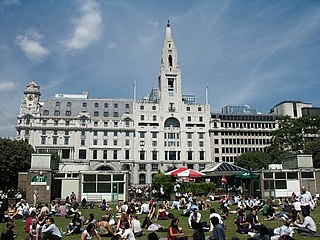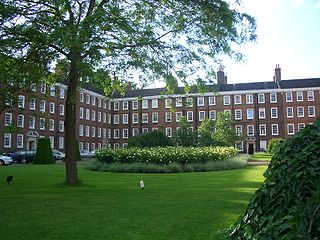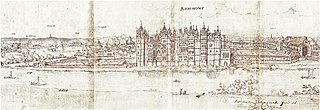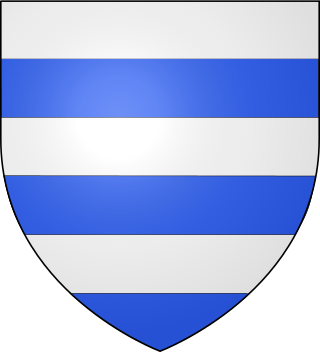Origins of the name
Some authors have speculated, without linguistic analysis, that the "Port" in Portpool refers to a gate [6] or a market [usurped] . However, the earliest references to the name of the manor indicate that the first syllable is "Purt" ("Purtepol" c.1200 and 1203; "Purtepole" 1220 and 1309; "Pourtepol" 1316). This shows that it cannot be "port" in any sense of that word but instead a personal name, "Purta". It is therefore "Purta's Pool". [7] Certainly, it has not been convincingly shown that "port" refers to any particular gate or market, and indeed the idea of locating a gate or market near a pool is a little unusual.
Related Research Articles

Finsbury is a district of Central London, forming the southeastern part of the London Borough of Islington. It borders the City of London.

Holborn, an area in central London, covers the south-eastern part of the London Borough of Camden and a part of the Ward of Farringdon Without in the City of London.

The Honourable Society of Gray's Inn, commonly known as Gray's Inn, is one of the four Inns of Court in London. To be called to the bar in order to practise as a barrister in England and Wales, an individual must belong to one of these inns. Located at the intersection of High Holborn and Gray's Inn Road in Central London, the Inn is a professional body and provides office and some residential accommodation for barristers. It is ruled by a governing council called "Pension", made up of the Masters of the Bench and led by the Treasurer, who is elected to serve a one-year term. The Inn is known for its gardens, which have existed since at least 1597.

Hatton Garden is a street and commercial zone in the Holborn district of the London Borough of Camden, abutting the narrow precinct of Saffron Hill which then abuts the City of London. It takes its name from Sir Christopher Hatton, a favourite of Queen Elizabeth I, who established a mansion here and gained possession of the garden and orchard of Ely Place, the London seat of the Bishops of Ely. It remained in the Hatton family and was built up as a stylish residential development in the reign of King Charles II. For some decades it often went, outside of the main street, by an alternative name St Alban's Holborn, after the local church built in 1861.

Richmond Palace was a Tudor royal residence on the River Thames in England which stood in the sixteenth and seventeenth centuries. Situated in what was then rural Surrey, it lay upstream and on the opposite bank from the Palace of Westminster, which was located nine miles (14 km) to the north-east. It was erected in about 1501 by Henry VII of England, formerly known as the Earl of Richmond, in honour of which the manor of Sheen had recently been renamed "Richmond". Richmond Palace therefore replaced Shene Palace, the latter palace being itself built on the site of an earlier manor house which had been appropriated by Edward I in 1299 and which was subsequently used by his next three direct descendants before it fell into disrepair.

Gray's Inn Road is an important road in Central London, located in the London Borough of Camden. The road begins at its junction with Holborn at the City of London boundary, passes north through the Holborn and King's Cross districts and terminates at King's Cross railway station. It is designated as part of the A5200 road.
Sir Nathaniel Rich was an English merchant adventurer and politician who sat in the House of Commons at various times between 1614 and 1629.

The Bourne Estate is an Edwardian housing estate in Holborn, located in the London Borough of Camden. It is bounded by Clerkenwell Road to the north, Gray's Inn Road to the west, Leather Lane to the east and Baldwins Gardens to the south. It is also intersected by Portpool Lane, which forms part of the estate itself.

Sir Henry de Grey of Grays Thurrock, Essex (1165–1219) was a favourite courtier of King John of England.
Hugh Denys of Osterley in Middlesex, was a courtier of Kings Henry VII and of the young Henry VIII. As Groom of the Stool to Henry VII, he was one of the King's closest courtiers, his role developing into one of administering the Privy Chamber, a department in control of the royal finances which during Denys's tenure of office also gained control over national fiscal policy. Denys was thus a vital player in facilitating the first Tudor king's controversial fiscal policies.
Sheen Friary later also known as Richmond Priory (1414-1539) was a friary in Surrey, England, restored as a national gathering of Carthusians by Maurice Chauncy at Sheen under Mary I of England during part of her reign from 1553 to 1558.
Thomas Fisher or Hawkins, was an English politician.

The Mirror of Justices, also known in Anglo-Norman as Le mireur a justices and in Latin as Speculum Justitiariorum, is a law textbook of the early 14th century, written in Anglo-Norman French and traditionally attributed to Andrew Horn. The original manuscript is in the Parker Library, Corpus Christi College, Cambridge.

In British usage, the term townhouse originally referred to the opulent town or city residence of a member of the nobility or gentry, as opposed to their country seat, generally known as a country house or, colloquially, for the larger ones, stately home. The grandest of the London townhouses were stand-alone buildings, but many were terraced buildings.
This is a list of the etymology of street names in the London district of Holborn. Holborn has no formally defined boundaries - those utilised here are: Theobald’s Road to the north, Gray's Inn Road and the City of London boundary to the east, Victoria Embankment/the Thames to the south, and Lancaster Place, the north-west curve of the Aldwych semi-circle, Kingsway/Southampton Row to the west.
Thomas Shipman was an English poet. A collection of around 200 of his poems was published posthumously in 1683, edited by his friend Thomas Flatman. More recently his poem The Resolute Courtier was included in The Centuries' Poetry 2 - Donne to Dryden.
Francis Williams, also known as Francis Cromwell, of Huntingdonshire, was an English landowner and politician. He was elected MP for Huntingdonshire in 1572 and was appointed Sheriff of Cambridgeshire and Huntingdonshire in 1587.
References
- ↑ E. Williams, Early Holborn and the Legal Quarter of London, Vol 1, 1927.
- ↑ E. Williams, op. cit., para 599.
- ↑ Cal. Wills, i 48
- ↑ E. Williams, Staple Inn, 22, 38-44, and Douthwaite, Gray's Inn, 3-18
- ↑ John Timbs, Curiosities of London, 1867
- ↑ E. Williams, Early Holborn and the Legal Quarter of London, Vol 1, 1927
- ↑ J.E.B. Gover, The Place Names of Middlesex, London, 1922, pp 70-1 and 105.